Frontier
Social Life
As settlements developed, neighbors became more important. They could be expected to help raise a barn, clear stumps in a field, aid with harvesting crops, and assist in quilting.
Relatives and neighbors were also needed in times of illness or death. Women were thought to have a healing touch, so if a housewife was sick, a nearby woman would come to take care of her.
This might include giving medicine, bathing a patient with a fever, offering comfort, or calling for help. If there was a death, neighborhood women would help prepare the body for burial, cook food for the bereaved family, and sit with the body.
This was also the time of social childbirth. A woman’s female relatives and neighbors attended her while she was giving birth. Midwives would tell the husband “it was time to call her women,” meaning birth was imminent. A couple of women would help the midwife with the birth while the rest offered emotional support. They would be there to take care of the baby and celebrate its birth, or, as was sometimes the case, mourn the baby’s death.
There was also a social custom of “calling on” one’s neighbors and friends. Most of this was done by women. The purpose was just to sit and talk. It also gave women a welcome break from their everyday chores.
Men tended to travel away from the home more than women, and to travel longer distances. They would often travel by horse, and stay at inns along the way. The custom of the time was to share beds at the inns—men with men, and women with women. A traveler might find himself sleeping in the same bed with a complete stranger!
Having fun
Entertainment on the frontier often took the form of work. Neighbors and friends gathered to raise a barn, harvest corn, or quilt a bedspread. During these gatherings there was food, drink, and possibly a dance at the end.
Martha Ballard, who was a midwife in Maine, kept a diary. One entry from 1790 described how her daughters had “15 ladies” over to help them finish a quilt. They started at 3 p.m. and finished by 7 p.m. when “12 gentlemen” came over. After everyone ate supper, they danced awhile. Martha writes that all “behaved exceeding cleverly,” and that all were home by 11 p.m.
More rambunctious activities, mostly involving men, included gambling, card games, cockfights, drinking, and skill contests such as axe throwing. In 1787, Ballard records in her diary that the locals raised a sawmill frame, followed by dance and dispersal at midnight. She notes approvingly that “not many were disguised (drunk) by liquor.”
Children played tag and blindman’s bluff, shot marbles, played with dolls, and whipped tops. While girls from higher-class homes were restricted in their activities, those on the frontier could join in their brothers’ games.
Picture Credits:
- Drawing entitled, “An old-time wedding party in West Virginia.” This drawing was published sometime between 1879-1889 in the work From American art and American art collections ,” by William Ludwell Sheppard. It shows newlyweds riding on horseback and being followed by a procession of well-wishers. New York Public Library
- Drawing entitled, “Abigail relates her misfortunes.” It shows a group of people listening to a story told by a young woman. This drawing was made by Howard Helmick and published in 1893 in Century Magazine. New York Public Library
- Photograph showing a group of re-enactors dressed as frontier settlers. It show the group gathered outside of a wood building. This photo was taken at Mansker’s Station in Goodlettsville, Tennessee. Courtesy of Historic Mansker’s Station
- Photograph showing a re-enactors dressed as a frontier family. It show a woman, a girl, and a baby sitting outside of a wood dwelling. This photo was taken at Mansker’s Station in Goodlettsville, Tennessee. Courtesy of Historic Mansker’s Station
- Photograph of a frontier re-enactor demonstrating ax throwing. This photo was taken near Knoxville at Marble Springs, the home of John Sevier. Tennessee State Photographic Services
- Photograph showing a group of women frontier re-enactors gathering for social time. This photo was taken in 2007 in Elizabethton, Tennessee. Friends of Sycamore Shoals State Historic Area
Frontier >> Living on the Frontier >> Everyday Life >> Social Life
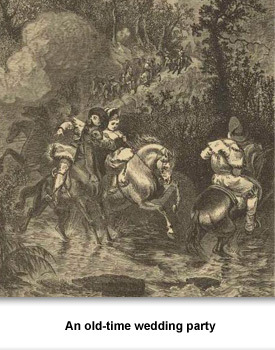
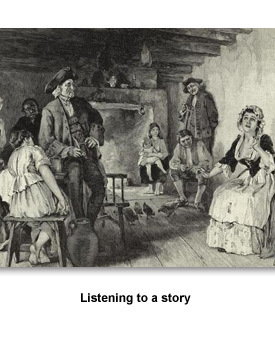
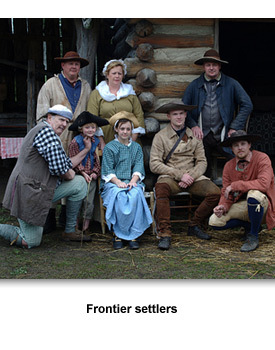
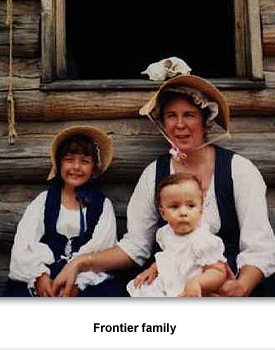
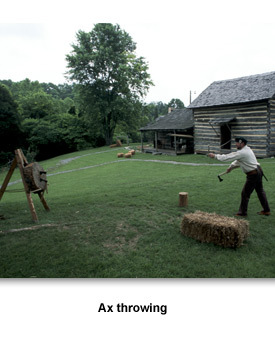
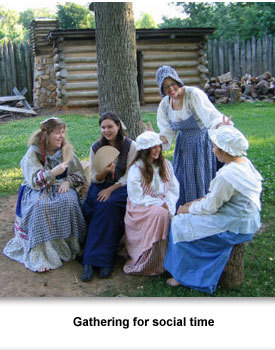
 Sponsored by: National Endowment for the Humanities
Sponsored by: National Endowment for the Humanities